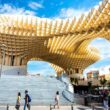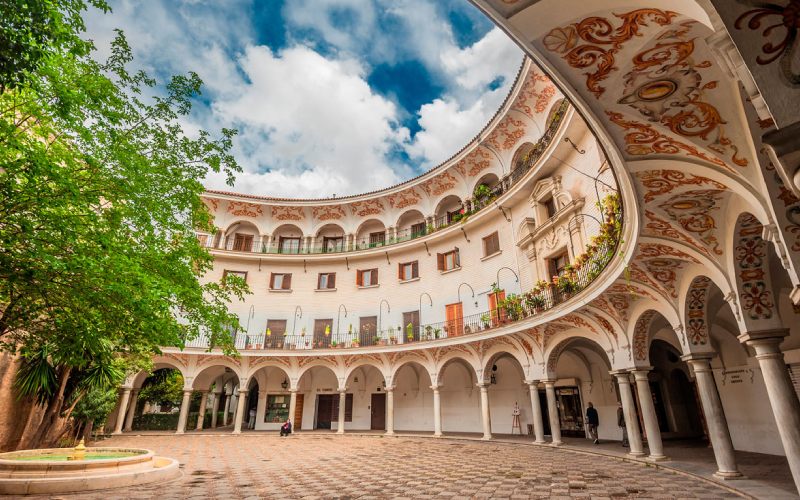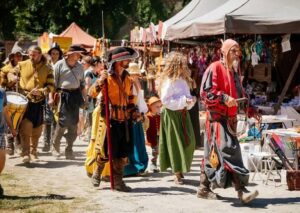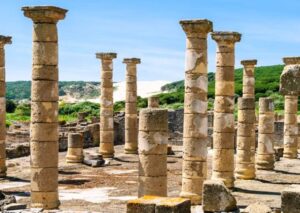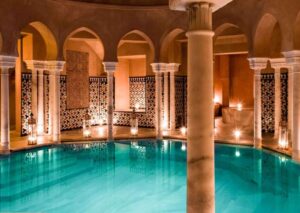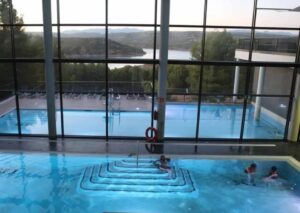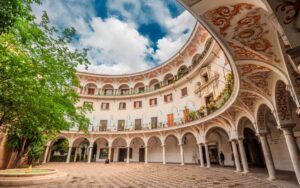- Plaza de Santa Catalina
- Plaza del cabildo
- Plaza de España
- Plaza de la Trinidad
- Plaza de San Nicolás
- Plaza de la Corredera
- Plaza y calleja de las Flores
- Plaza de los Naranjos
- Plaza del Obispo
- Plaza de las Flores
- Plaza de españa
- Plaza del Pósito
- Plaza de Vazques de Molina
- plaza san pedro
- Plaza de la Laguna
- Plaza Vieja/Plaza de la Constitución
- Mirador de la Plaza Nueva
➡️ Latest content update: 26 May, 2025
Andalusia holds among its streets and corners authentic urban treasures that tell centuries-old stories: its squares. These spaces full of life are much more than simple places of passage; they are the heart of towns and cities where Andalusians live our lives. From monumental ones like Seville’s Plaza de España to small hidden gems like Córdoba’s Calleja de las Flores, each has a unique personality that captivates you as soon as you set foot on it.
The scent of orange blossoms in spring, the murmur of fountains, the laughter shared on terraces under the sun, and that indescribable atmosphere that mixes history and present… All of this is what makes Andalusian squares experiences that go beyond the visual. I invite you on a journey through those spaces where time seems to stand still and where, among orange trees, geraniums, and the conversations and laughter of people, you’ll discover the authentic soul of Andalusia. Get ready to fall in love with every corner!
Plaza de Santa Catalina
📍 conil de la frontera (cádiz)
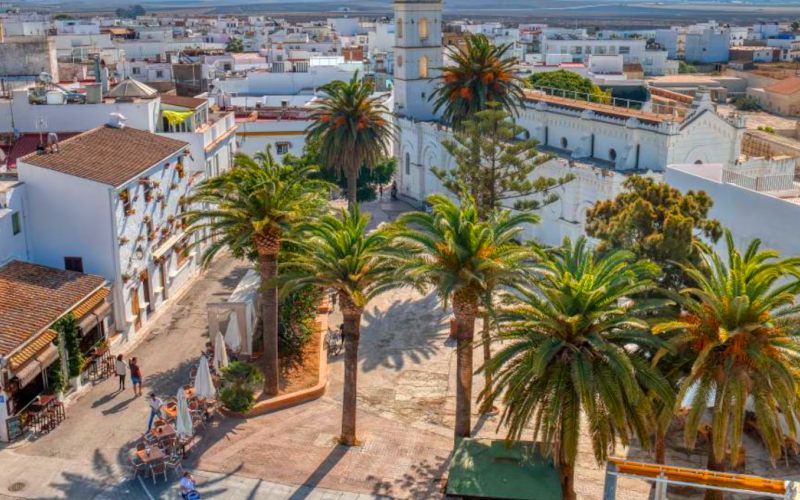
Currently known as Plaza de Santa Catalina, this emblematic space in Conil functioned as the Main Square until the end of the 19th century. This historic nucleus housed the most significant constructions of the town, including the castle, municipal buildings, the prison, the parish dedicated to Santa Catalina, the Jesús sanctuary, and residences belonging to the wealthy families of the town.
The square underwent an important transformation in 1891 when several houses located in front of the fortress were demolished. This urban intervention allowed for the appreciation of the new parish church and gave rise to a small landscaped space that notably embellished this public environment.
Plaza del cabildo
📍 seville (seville)
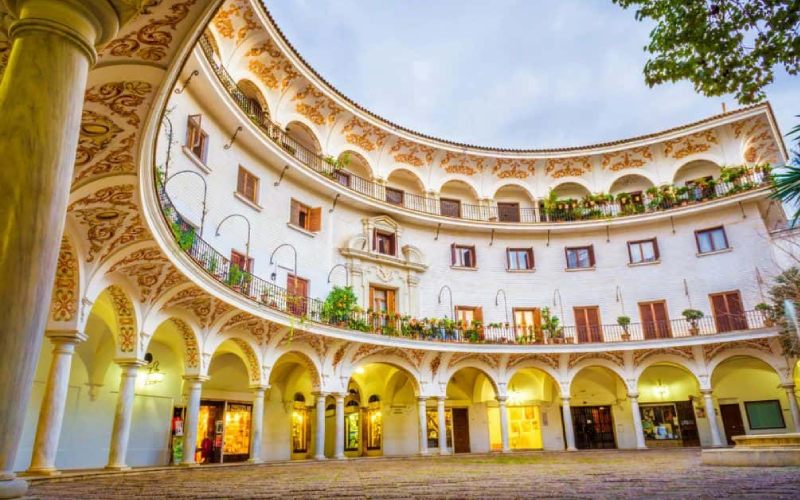
Located in front of the Cathedral in the traditional Arenal district, this small semicircular square preserves important historical vestiges. One of its sides is occupied by a fragment of the inner Almohad wall built in 1184, while its surroundings were built on the grounds of the former College of San Miguel, belonging to the cathedral chapter.
After the demolition of the college in the mid-20th century, only the facade that opens to Constitución Avenue and some columns reused in an inner courtyard survived. The current architectural work was designed by Joaquín Barquín Barrón.
Access to this urban space is through the surrounding buildings, which connect with Arfe and Almirantazgo streets and with Constitución Avenue. Every Sunday, the square takes on special life when it hosts a picturesque market dedicated to philately and other curiosities.
Plaza de España
📍 seville (seville)
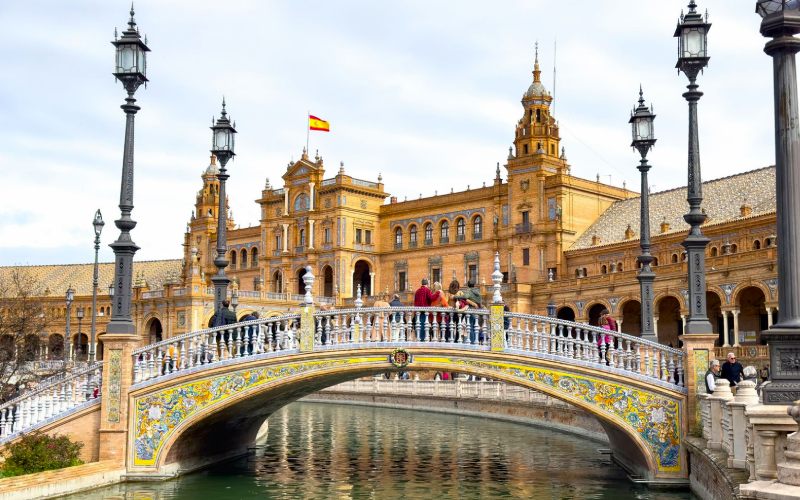
A masterpiece by architect Aníbal González for the 1929 Ibero-American Exposition, this monumental semi-elliptical square located in María Luisa Park symbolizes the bond between Spain and America. With 50,000 square meters, it has a navigable canal of 515 meters bordered by four bridges representative of the ancient Spanish kingdoms.
Its iconic elements include the semicircular lake, the twin towers, and the characteristic tile benches that illustrate the Spanish provinces. A cinematic setting in films such as Lawrence of Arabia and Star Wars, its central space can host events for up to 10,000 people.
Plaza de la Trinidad
📍 granada (granada)
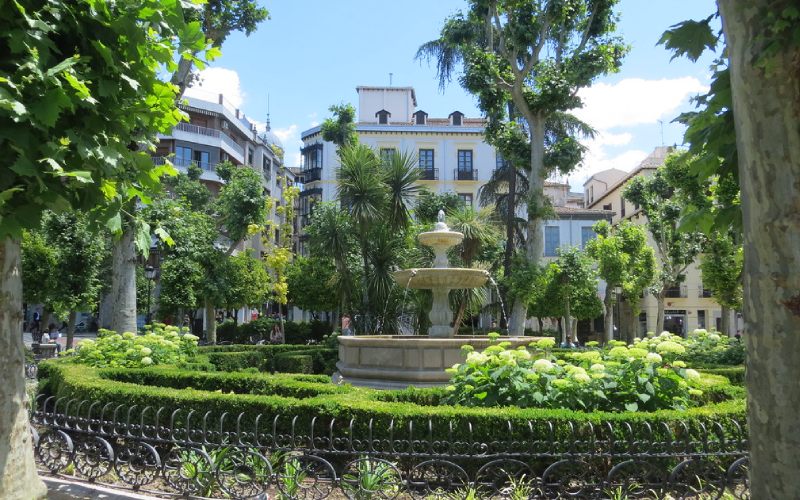
Strategically located between the Cathedral and Plaza de los Lobos, Plaza de la Trinidad constitutes a nerve center in Granada’s commercial center. Important commercial arteries such as Mesones, Alhóndiga, and Pescadería converge in it, making it a must-visit space.
A peaceful place in the historic center offers a respite from the urban hustle, where visitors can enjoy the relaxing sound of water from its fountain and the singing of birds among its peculiar vegetation, which includes fruit trees and Japanese spindles.
Plaza de San Nicolás
📍 granada (granada)

Considered one of the most emblematic points of Granada, the San Nicolás Viewpoint rises in the historic Albaicín neighborhood offering an incomparable perspective of the majestic Nasrid Alhambra, with the city at its feet and Sierra Nevada as a backdrop.
This Granadan corner reaches its maximum splendor during sunset, when light bathes the palatial fortress creating an unrepeatable chromatic spectacle that attracts both locals and visitors eager to capture this unique image.
The surroundings of the viewpoint complement the visual experience with a gastronomic offer in its vicinity, allowing you to taste traditional dishes while enjoying this essential place that harmoniously fuses history, culture, and natural beauty.
Plaza de la Corredera
📍 córdoba (córdoba)
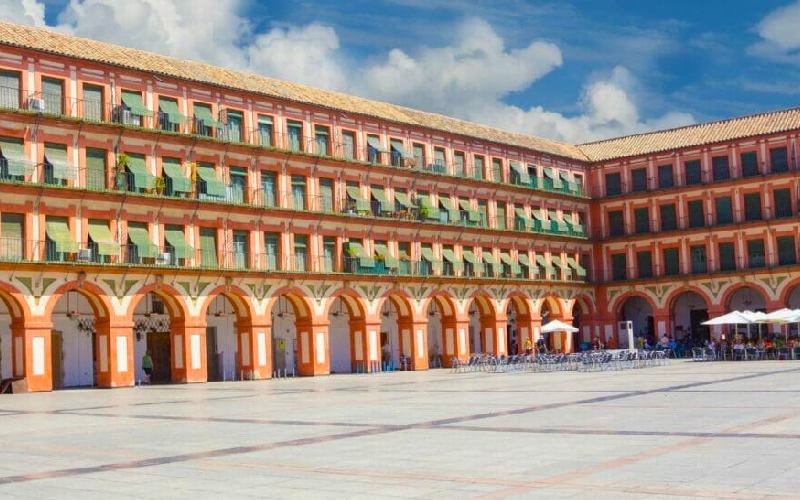
Seated on what was possibly part of the Roman Circus, Plaza de la Corredera has revealed valuable archaeological treasures, including magnificent Roman mosaics currently exhibited at the Alcázar of the Christian Kings.
Its peculiar rectangular and porticoed design with arches on its lower floor directly links it to Castilian architecture, making it a unique specimen in Andalusia. For centuries it served as an improvised bullring, a legacy that survives in the name of the Toril alley that is still preserved.
This historic space, which was the scene of proclamations, acts of faith, and executions during the French invasion, has transformed its function over time. Currently, it has been converted into a lively leisure center where cafes and bars offer a relaxed atmosphere for locals and visitors.
Plaza y calleja de las Flores
📍 córdoba (córdoba)
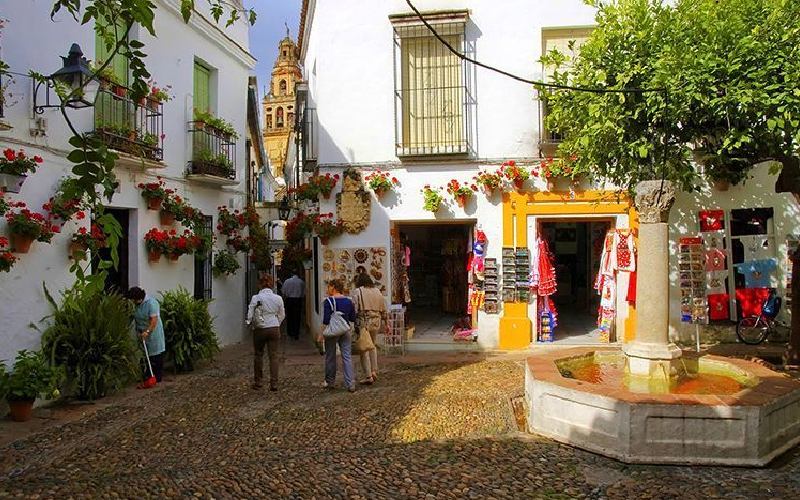
Located in the historic Jewish Quarter, the Calleja and Plaza de las Flores represents one of the most emblematic spaces of Córdoba tourism. This corner is a short distance from the Mosque-Cathedral, offering its visitors an authentic sensory journey.
The narrow alley with its characteristic arches and stone pavement leads to a cozy small square where numerous flowery pots adorn walls and balconies, creating that typical atmosphere that has turned this place into a must-see postcard of the city.
One of the main attractions of this tourist enclave is the magnificent panoramic view it offers of the imposing tower of the Mosque-Cathedral, thus merging in a single image the essence of traditional Cordovan architecture with its most representative monument.
Plaza de los Naranjos
📍 marbella (málaga)
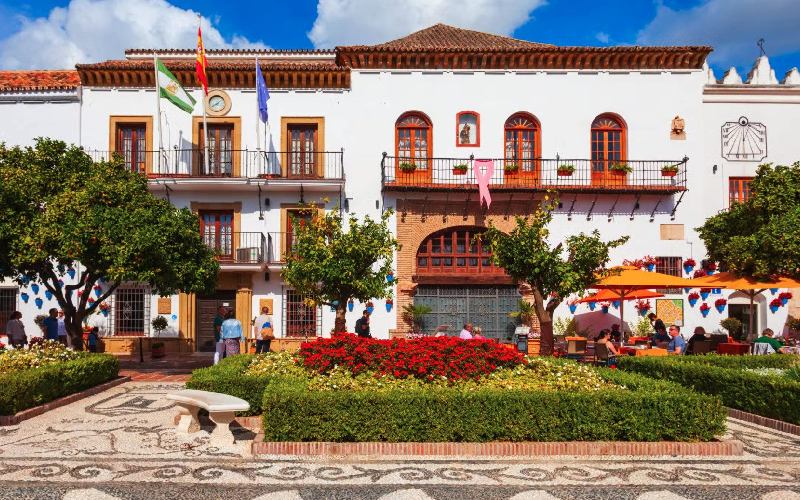
Plaza de los Naranjos was conceived as the nerve center of Marbella, becoming the quintessential noble space of its social life.
In this strategic enclave, emblematic buildings were established: the already existing hermitage of Santiago, the Town Hall, the inns, the jail, the Corregidor’s House, and several stately mansions.
Throughout its history, this space has experienced a curious nomenclature evolution, being successively known as Plaza Mayor, del Ayuntamiento, de Riego, de Isabel II, de la Libertad, de la Constitución, de las Palmeras, de la República, and del General Franco.
Its current name comes from the orange trees planted in 1941, which replaced the previous palm trees, which had replaced the primitive Indian chestnuts.
Plaza del Obispo
📍 málaga (málaga)
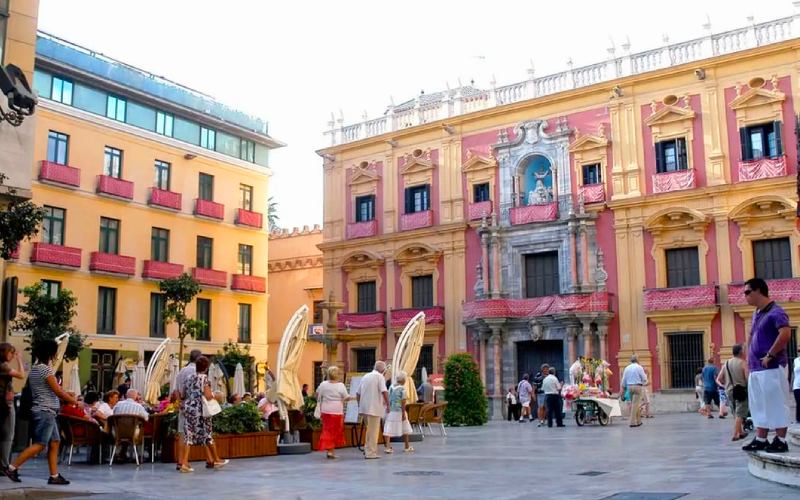
Considered the baroque space par excellence of Málaga, Plaza del Obispo constitutes one of the most significant urban enclaves of the city since ancient times. This historic complex is presided over by the Episcopal Palace, whose construction began in 1762.
Facing this building stands the main entrance of the emblematic Málaga Cathedral, popularly known as “La Manquita.” Its imposing facade is complemented by majestic marble stairs that descend to the level of the square, with the temple delimited by an elegant fence.
The central point of this space is an anonymous stone fountain from the 18th century, contemporary to the Episcopal Palace. This hydraulic structure, which originally supplied water to the neighbors, was connected with another important tourist attraction of the city: the San Telmo Aqueduct.
Plaza de las Flores
📍 cádiz (cádiz)
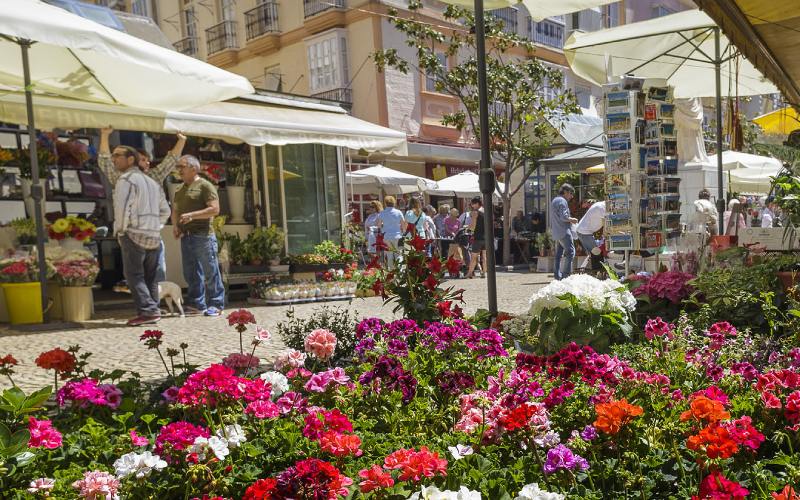
In the heart of Cádiz is Plaza de las Flores, a lively urban space characterized by the colorful flower stalls that occupy its central part, giving it a special atmosphere and a unique fragrance.
This historic square houses notable architectural examples such as building number 1, built in 1746 and distinguished by its typical Cádiz Baroque facade framed by pilasters. Equally noteworthy is building number 12, a neoclassical work designed by Torcuato Benjumeda, whose upper structure is articulated by giant Doric pilasters.
The daily vitality of this enclave intensifies especially during Carnival festivities, when along with the nearby Plaza de la Libertad it becomes the main stage for street performances by colorful carnival groups.
Plaza de españa
📍 vejer de la frontera (cádiz)
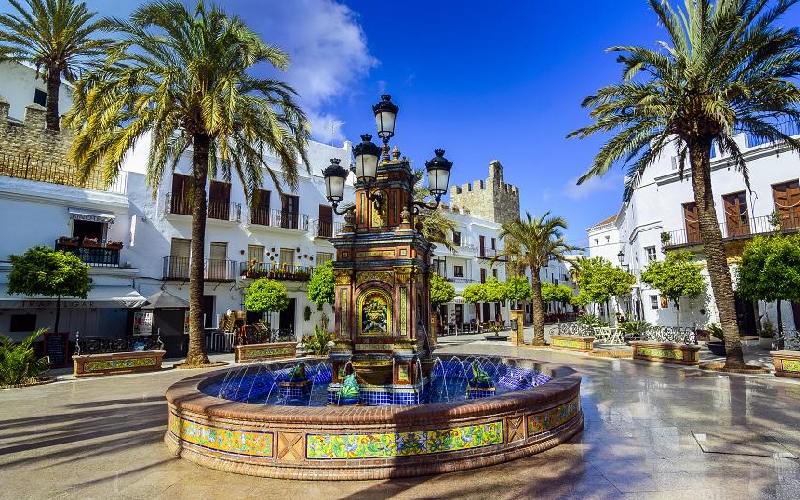
Converted into the vital center of this Cádiz town, Plaza de España constitutes the favorite meeting point for neighbors and visitors. This emblematic urban space, characterized by its surrounding palm trees, houses important institutional buildings such as the Town Hall and the Justice of the Peace Court.
With a rich historical past, during the 15th and 16th centuries it served as a stage for bullfighting celebrations. Currently, this enclave hosts the main events of the municipality, including the Velada in Honor of the Patron Saint La Virgen de la Oliva.
The numerous gastronomic establishments surrounding the square offer an excellent local culinary sample, featuring fresh fish and seafood from the coast, the traditional fried “pescaíto,” retinto meat, loin in butter, and various dishes of Andalusian heritage. This combination of history, culture, and gastronomy makes the square a mandatory stop for all tourists.
Plaza del Pósito
📍 Jaén (jaén)
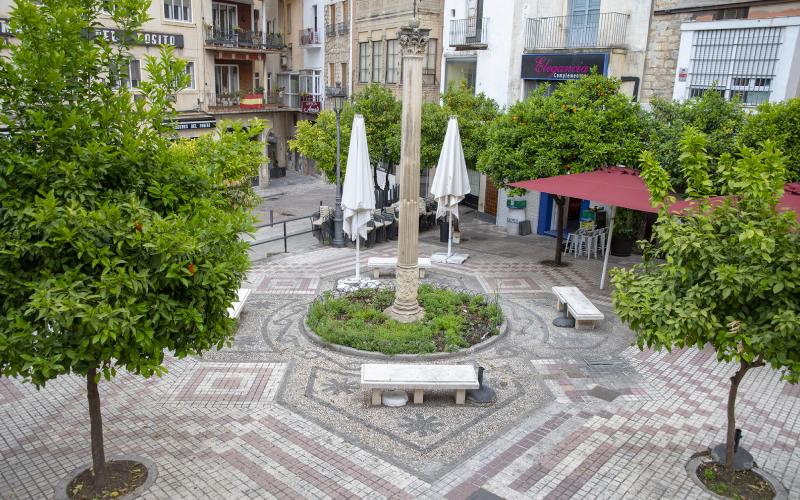
Located near the Cathedral, between the Provincial Palace and the Vílchez Palace, this square is the scene of important local legends. It owes its name to the old municipal granary built in 1547, a public grain warehouse that functioned as a reserve for times of scarcity.
Although the three-story building was demolished in 1921, its facade with the coat of arms of Charles I is preserved in the Provincial Museum. The square still maintains historical elements such as the Pósito Cross and the characteristic fountain with spouts in the shape of lion heads.
Plaza de Vazques de Molina
📍 úbeda (jaén)
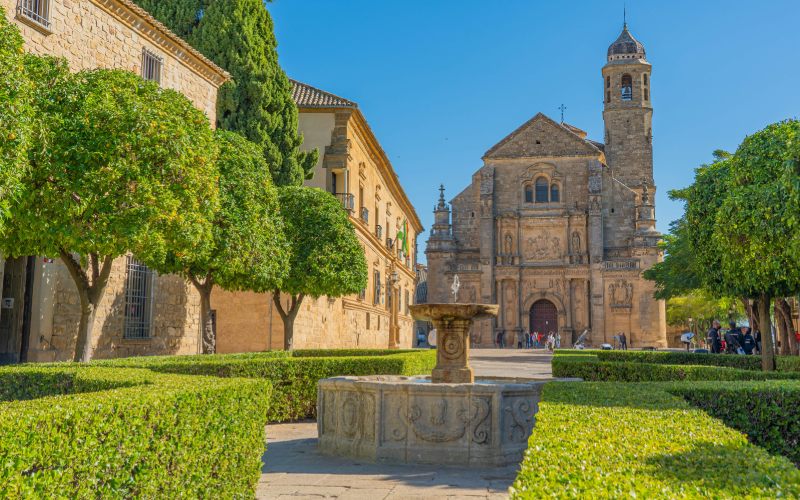
Plaza de Vázquez de Molina constitutes an authentic open-air museum, where each corner reveals an architectural masterpiece. This exceptional monumental complex houses some of the most emblematic buildings of Úbeda: the Town Hall (or Palace of the Chains), the Tourism Parador in the Dean Ortega’s Palace, the Marquis of Mancera’s Palace, the Sacred Chapel of El Salvador, the Basilica of Santa María de los Reales Alcázares, and the old Granary.
This extraordinary urban space is completed by the monument dedicated to Andrés de Vandelvira and an elegant Renaissance fountain, elements that contribute to the singular beauty of this historic square.
plaza san pedro
📍huelva (huelva)
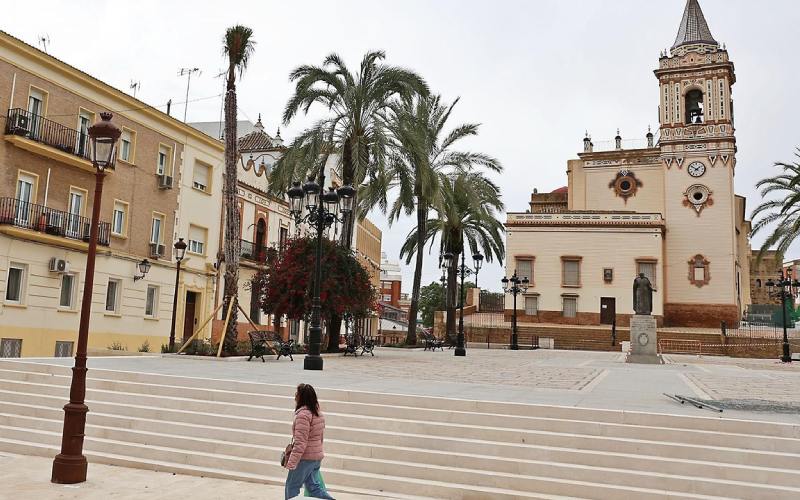
Plaza de San Pedro: Tradition and Modernity in Huelva
The historic Plaza de San Pedro, an emblematic enclave of Huelva, has been renovated maintaining its characteristic essence with its traditional square flanked by palm trees while incorporating modern accessibility solutions. This space combines noble materials such as granite and marble to create both a contemporary and historic atmosphere.
Converted into an authentic window to the past, the square allows contemplation of valuable archaeological vestiges that include Roman and Christian remains in a cistern, the layout of a main Andalusian road, and Almohad structures on which the church of San Pedro was built in the 14th century. The recent inauguration featured an emotional act where neighbors and authorities participated with music and Christmas carols.
As highlighted by Mayor Pilar Miranda, this intervention represents an unprecedented commitment to heritage conservation, seeking a balance between urban development and respect for the city’s historical legacy.
Plaza de la Laguna
📍ayamonte (huelva)
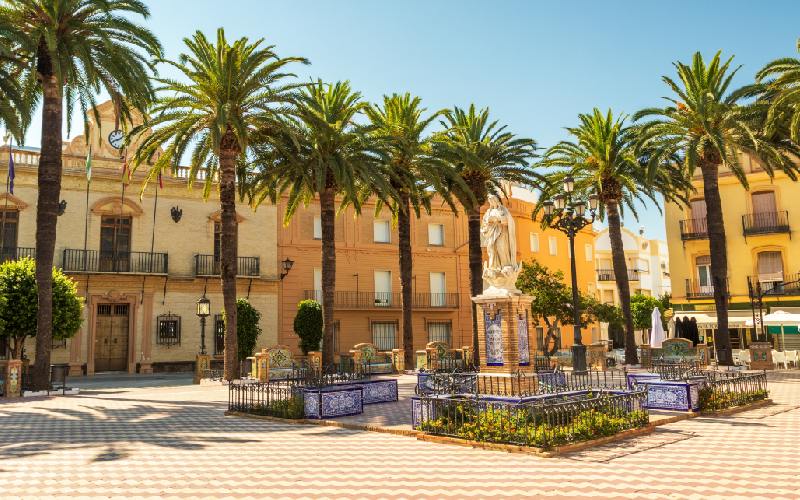
Plaza de la Laguna in Ayamonte recently celebrated its 75th anniversary, having witnessed the evolution and transformation of this border town for more than seven decades. Designed by the illustrious provincial architect José María Pérez Carasa, it was inaugurated in 1944 by parish priest Juan Ainé Carbonell.
Among its most characteristic elements are the decorative tiles designed by Prudencio Navarro Pallarés and the white stone statue of the Immaculate that has presided over the space since 1954, on a base with the inscription: “Ayamonte to the Immaculate Conception, Marian Year MCMLIV.”
This charming and beautiful square occupies a strategic place in the heart of the municipality, close to the historic 18th-century Town Hall, the dock, and other places of interest in the Huelva town.
Plaza Vieja/Plaza de la Constitución
📍almería (almería)
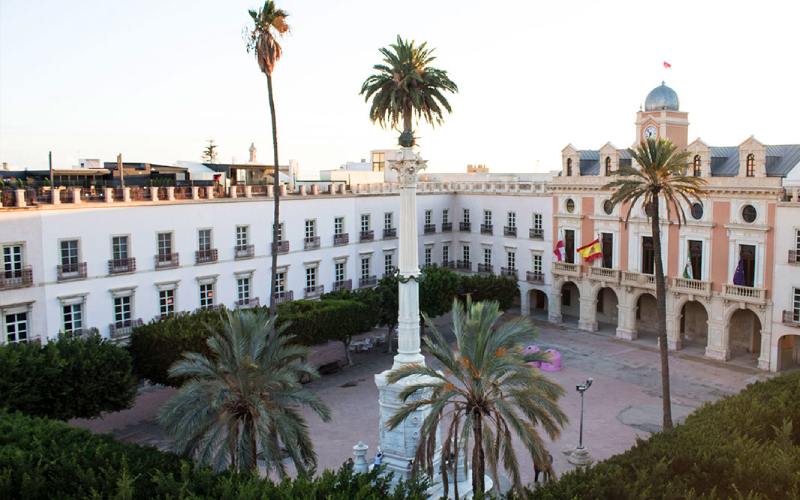
Also known as Plaza Vieja, it constitutes the oldest urban space in Almería, located in an endearing corner of the city. Throughout its history, it has been the scene of multiple activities such as games, bullfighting festivities, processions, and civic acts.
During the Muslim era, it functioned as the main souk with an irregular shape, while after the Christian conquest it was known as the “Juego de las Cañas” square. Its definitive configuration was established in the mid-19th century, adopting a slightly trapezoidal plan with the characteristic arcades and two-story dwellings typical of nineteenth-century porticoed squares.
This space is presided over by the eclectic Town Hall building, built between the late 19th and early 20th centuries, whose tripartite facade culminates with a central tower crowned by a hemispherical dome that houses the clock and the municipal coat of arms.
Mirador de la Plaza Nueva
📍mojácar (almería)

Considered the vital nucleus of Mojácar activity, Plaza Nueva functions as an ideal meeting point both to start a visit and to contemplate its spectacular sunsets. Its main attraction is the homonymous viewpoint, which offers an exceptional panoramic view of the extensive valley limited by the Cabrera, Bédar, and Almagrera mountains.
From this privileged natural balcony, one can clearly appreciate the course of the Aguas River at the foot of Mojácar La Vieja (ancient original settlement) and its mouth in the lagoon. The landscape is completed with the neighboring towns of Turre, Bédar, Los Gallardos, Vera, Garrucha, Cuevas del Almanzora, and Villaricos, in addition to the traditional Mojácar orchards.
The square also houses the historic Hermitage of Our Lady of Sorrows, a private temple dating from the 16th century.
↓ ↓ ↓ ↓ ↓


